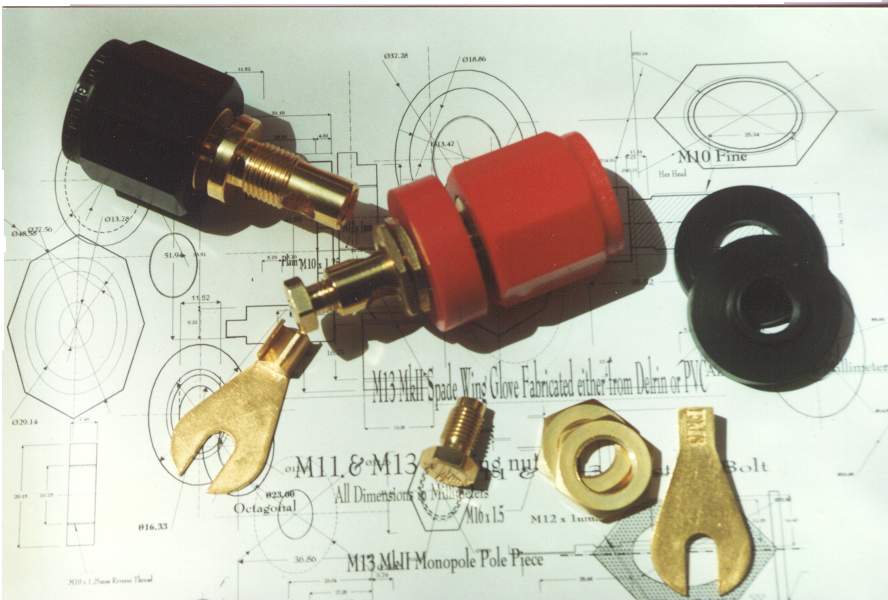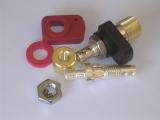Monopole®
The Audio Terminals / Pure Copper Binding Posts.
Why the Monopole®?
It all started in 1983/4 when I was involved
in the design and fabrication of water electrolysis welders. These devices
used a small cylindrical cell with interlocking positive and negative mild
steel electrodes immersed in a NaOH bath. The bath was automatically topped
up with water as its water level was depleted by virtue of the effect of
the electrolysis. Hydrogen and Oxygen were electrolysed in the same cell
and the gas mixture was burnt in a standard oxy/acetylene torch. Its temperature
being considerably higher than a normal oxy/acetylene flame. But there
was one constantly recurring problem with this apparatus. Despite the high
current : 120 Amperes, the power signal from the supply transformer would
often fail to reach the electrolysis cell. This primarily due to the low
voltage being used: 2 Volts. The slightest bit of grease or grime on the
contactor would void the transmission of the electrical signal. Being a
keen audiophile at the time, it occurred to me, what if the same thing
could be happening in the audio chain. Thus began the process of investigating
whether the information carried in the audio pathways from source to speaker
was degraded at its interface changes. The answer soon became quickly evident:
Yes! So what to do from here!
1987
The BMNP-M11
was made from assembling off the shelf componentry and a few custom-made
parts, in an effort to begin the process of eliminating or minimising the
effects of signal deterioration at one of the critical interface signal
transfer points; i.e. from the amplifier to the loudspeaker. The M1 did
exhibit some improved response but not of sufficient significance so as
to be able to say that there was clearly some considerable improvement
in the quality of reproduction. The paradigm was tinkered with for the
next 4 years .
1991/92
The M2, M3 ? M4:
All subtle variants of each other and each
seeking to achieve a particular design target, were inevitable steps in
working through predetermined mind-sets as to how the target was to be
achieved.
At first it appeared that the surface area
across which the signal was transmitted was a critical parameter, next
it became apparent that the type of conductor being used was also significant.
If the surface area of the transmitting surface
and receiving surface were considerably increased there should be some
measured improvement in the quality of the signal transferred. Against
what was this to be measured? The voltage and current transfer appeared
to be identical ‘fore and aft’ of the transfer interface; yet there was
an appreciable improvement in the perception of the quality of the information
being reproduced ( as the surface areas at the transfer interfaces were
increased)2 . It was also beginning to
become apparent that there was an improvement curve of the quality of reproduction
as each design variant evolved from its predecessor.
The evolution being from Brass to Bronze and
then to Copper as with the M5.
1992/93
M5
First drift from the mind-set. The M5. This
was a bolt centred device in which a bolt secured the wire into the body
of the Monopole®. Each of the input and output sections were mirrored
around a central flange and separated by only 10mm of copper. This was
the first considerable quantum improvement in sound quality from the first
4 previous designs. The M6 and M7 soon followed. These, though were too
bulky and the M8 ( which was never built ) was bigger still. Neither the
M6 nor M7 proved to be an improvement on the M5. So the M9 was born. 1993/94
M9
The M9 was a straight piece of 25mm diameter
copper billet that was tapped into at each end with an M16 thread and separation
between conducting faces of 12mm. It was as close in design to the M5 as
one could be. It was also an improvement and easier to adapt though not
very practical from a commercial point of view, due to the fact that there
was only one bolt and insertion hole at either end for bare wire. Everyone
to whom it was shown cried: What about spades, bananas etc.. What was beginning
to become apparent through the separate designs of the M9 and M5, was that
the optimum performance for an audio binding post at the interfaces covered
by the binding post could only be achieved through a particular design
paradigm since patented by myself and the common design paradigm throughout
the current production Monopoles®. This has since been the principle
design paradigm of all subsequent Monopole® after the M10.
M10
The M10 was the first attempt to address ease
of installation of the Monopole® into its appliance with the first
use of a twin-bolt mechanism. This accommodated all manifestations of connectors
and wire endings, but diverged from the new design philosophy of accommodating
bare-wire within the appliance bolted directly into the body of the binding
post. The M10 had a threaded shaft ( in its internal to the appliance section
) for securing nuts and solder lugs for the internals of the appliance
. Audio did not sound as well as for the M9 or M5.
1994/5
M11
1995
M12
Many who saw the M11 asked for a smaller version.
The M12, identical in topology to the M11 but a few sizes smaller showed
that it is not possible to fabricate scaled down sizes of the M11 design
cheaply. The only cost benefit was the reduction in the material costs
and some reduction in the electroplating costs. Even though the M12 was
of identical topology to the M11 it did not sound as ‘Transparent’ as the
M11. The M12 was not added to the current line-up for this reason.
The M12 is discontinued but was an important
design step to the M26 described below.
The M13 and
IEC-65 and IEC-CE
With the advent of the imposition of IEC-65
in Europe in 1996 the M135
was designed. It meets all the requirements of the new IEC-65 standard
but departs only slightly from the original design criteria of the Monopole®
as primarily a ‘bare-wire’ binding post. It will accommodate bare wire
but is a return to the shaft centred design of the M1-M4 with the refinements
of the M11. Internally ( in its fitted appliance ) the M13 is identical
in size and configuration to the M11. Externally its Nut is fully insulated
and can only be screwed out to a maximum of 3.8mm. The M13 is the largest
of all the current production Monopoles®. Its external diameter is
41mm and external signature6 on its working
appliance is 45mm.
In my listening tests the M13 stands out from
the other designs that are mentioned here. It is also the most expensive
of all the Monopoles® to fabricate. In a series of blind tests the
M13 gives the reproduced audio signal just that much more sense of presence
and intimacy. Perhaps the insulation acts to minimise mutual inductance
between binding posts. The other binding posts are, though, better than
any other audio binding post available anywhere in the world today.
Much of the design and evaluation of the M13
? M14 was done in the quiet of the country side more than 100 kilometres
from the nearest city and high in the Great Dividing Range mountains in
South Eastern Queensland. My noise meter reading the background
noise down to a low 18db on the stillest nights and averaging around 22db
- 26db on normal windless nights. With these levels of background noise
it becomes easier to appreciate the dynamic range capable of a CD but also
to appreciate the amount of information that a record stylus is able to
glean from a vinyl record.
Nuances and subtle differences between different
components that may offer even the subtlest of improvements can be compared
and evaluated. It was in this environment that there was a distinctive
‘blooming’ of the reproduction of the audio signal with the M13. The M11
and M14 were a close, very close second.
Though it would be easy to
consider my judgement somewhat biassed, I believe that the M13Mk IV ? V
variants are the best audio binding posts ever fabricated. The M13 is the
best of the best.
To view a low resolution
image of the M13 MkV click on the image.
IEC-CE
The M13 MkV is fully IEC-CE compliant. It
has no provision for banana connectors and is solely a spade binding post.
It only opens out to a maximum of 3.0 +/-0.5 millimetres
M14
M26
( The Feral Fox )
This is the barest bone Monopole®. All
the fastening and assembly components for all the other Monopole® designs
are fabricated especially for each model to ensure complete accuracy for
installation and performance.
The M26 does not use the junction assembly
for the securing of the internal appliance wire; instead it uses two M4
grub screws securing the appliance wire into a 5.0mm diameter x 26mm long
hole into the body of the pole piece.
Standard off the shelf nuts and M4 Stainless
Steel grub screws are supplied with each M26 Monopole®.
UHMW/PE insulators with A single SS locking
nut secures the M26 Monopole® securely into its appliance; whether
it is an amplifier or a loudspeaker, the M26 will deliver an improved
the performance on any brass connector or higher alloy copper connector
because the M26 Monopole® is made from Pure Copper.
Colour coded polarity indicators are also
supplied.
This Monopole® will accept standard spades
( with fork tongs > 7.0mm ) and also the FM21.
Click here to
see an image of the M26
Richard Fung, audiophile, comments on the
benefits of the M16
(This was the previous iteration of the M26.)
Banana's
Banana connectors have been banned in all
IEC-CE signatory countries. For this reason all Monopoles® are available
with or without provision for banana connectors. In Europe where a more
stringent application of IEC-CE has been enforced only the M13 MkV Monopole®
meets this standard. And is the only binding-post that does!
COMMON
PROPERTIES OF THE M11; M13 ? M14 MONOPOLE®.
All Bocchino Audio Monopoles® will handle
up to 200 Amperes ( continuous )12 1314With
transients up to 1200Amperes for as long as 100 milliseconds. Amplifiers
and loudspeakers that claim current capacities of up to + / - 600 Amperes15
are easily accommodated by all the current Monopoles®. This high current
capacity also allows extremely low power signals effortless passage through
the Monopole®. Face to face resistance along the shortest path16
is less than 5 Micro Ohms 1718.
To view the current versus temperature graph
click the duck. The temperature is in Degrees Celsius and current in Amperes.
The graph following is for M11 M13 and
M14 Monopoles® is an 61Kb .Jpeg document.
for Current carrying capacity graph for M12
/ M26 / M22 and M24 Monopoles® ( 82 Kb image ) click image>
G: Installation
Hole
ALL Monopoles® require
a 21mm hole in their operational appliance to be installed. The Nose of
the Mounting threaded shoulder washer is 20mm in diameter on all Monopoles®.
Hole centres should be a nominal 50 millimetres.
( This also applies to the M26 Monopole®
)
The improvement in the quality of sound reproduction
is a consequence of the high quality of materials, fabrication craftsmanship
and the large contact surface areas and especially the elimination of solder19
at the most important "transition" connections of the respective appliances
to which the Monopoles® are attached. The elimination of this resistive
connection at the appliance transition interface has an extremely dramatic
effect on the quality of audio reproduction. Transients are more immediate
and faster, thus reducing colouration to the point that many have called
the Monopole® the only transparent window to the true workings of ones’
audio appliances. Silences where they should be, crescendos that don't
hang around and musical instruments that sound like their real-life selves
and not like sine-waves.
Audio sounds as if it has been released from
a choking constriction. Music is freer, extended and more open, taking
the listener a quantum leap closer to the original performance. Instruments
do not appear as points in the stereo holographic image but as three dimensional
fields representative of their size and location. Timbral accuracy is closer
to the original live audition and vocals are presented with crisper diction.
Monopoles® put the endings on the words.
Better still. Try them. The caged canary becomes
the soaring condor.
In using firmly clamped unsoldered bare
wire all the way from the amplifier to the loudspeaker transducer, with
minimal componentry in the signal path, the quality of reproduction is
as close to live as modern technology allows .
Welcome to the ‘private space’
of the original performance.
Enjoy!!!!!!!!!!!!!!!!
Regards
Carmine Bocchino
( Design Engineer and Governing Director of
Bocchino Technologies )
Goto Monopoles®
Pricing.
Return to Bocchino
Audio contents page
Note1
BMNP standing for " Bocchino ‘Monopole®’
".
Note2
Incremental increases in the surface area
transfer interfaces demonstrated that there was a considerable improvement
in both quantity and quality of signal transfer up to 25mm in diameter
after which though there were ‘perceptible’ improvements in 50mm and larger
the degree of improvement did not warrant the expense and was also not
as noticeable as the improvement from 6mm dia to 25mm dia.
Note 5
Note6
The external signature is the amount of millimetres
that the Monopole® sits proud of the appliance interface.
Note7
The M14 has the smallest external signature
of all the Monopoles®.
Note8
At the spade insertion interface the M13 variants
locking nut and mating insulating washer are round to allow perfect trimming
of insulation on the spade lug.
Note9
Delrin is an Acetyl based polymer adapted
from the electrical transmission industry where it is used to isolate extremely
high voltage and high current carrying cable.
Note9b
Nickel has a distinct property in that in
the presence of an electrical field it will retain some residual magnetism.
This property is known as the Hall Effect! And inhibits the efficient transmission
of the audio signal thus leading to some signal degradation. It begins
from the second an electrical begins its transit through any connector
that has a Nickel substrate. One needs to demagnetize ones system on a
regular basis to counter the build up of this residual magnetism within
the Nickel plate layer. Where the signal path transition points are all
Bocchino Audio components there is no Hall-Effect and hence the system
will always sound open and whole because it is in a state of being ‘permanently
demagnetized'.
Note10
Pure Silver
has an electrical conductivity of 0.630 106/cm-Ohm
105.7% that of Copper.
Pure Copper
has an electrical conductivity of 0.596 106/cm-Ohm
100% that of Copper.
Pure Gold
has an electrical conductivity of 0.452 106/cm-Ohm
75.8% that of Copper.
Rhodium
has an electrical conductivity of 0.211 106/cm-Ohm
35.4% that of Copper.
Nickel
has an electrical conductivity of 0.143 106/cm-Ohm
24% that of Copper.
Brass
has an electrical conductivity of 0.137 106/cm-Ohm
23% that of Copper.
Tin
has an electrical conductivity of 0.092 106/cm-Ohm
15.4% that of Copper.
Carbon
has an electrical conductivity of 0.00061 106/cm-Ohm
0.102% that of Copper.
Hence Silver is the best room temperature electrical conductor in the known
universe: followed by Copper and then Gold. Gold has the distinct advantage
in that it does not corrode and hence electrical contacts plated with Gold
remain corrosion free for most of their working life and conduct the electrical
with minimum distortion or heat dissipation. ( Gold has an albido of 1:
it gives what it gets ).
Brass and Nickel used in standard audio electrical
binding posts each have conductivities 4 times less than Copper or Silver.
Doubtless economics and fashion plays an important part in the choice of
materials. Not every manufacturer will fabricate their componentry
from the best available materials;l but with good marketing you can sell
anything!
Presently room temperature super-conductors
are not yet available. We are stuck with Copper, Silver and Gold; which
I think will do for the time being.
If you want an independent opinion on the
electrical and other properties of the elements download the Periodic Table
Software from SMI Software
site .
Or go to the Web
elements by clicking these links.
Note11
Silver Copper has a conductivity of 100% -
102.5% that of Normal Copper and a machinability index of 20; It contains
a minimum of 0.5% Silver.
Note12
Calculated using: R=( r x L )/A ; W=I2R
; dT= (W/3.6)/(M x c).
Note13
110 A continuous results in dT=0.5OC
; 220 A continuous dT=2OC. Normal listening will not
cause any perceptible temperature rise.
Note14
Acceptable factors of safety deem that the
true domestic operational duty of Monopoles® not exceed 200 Amps continuous
with 400 amps for no more than one second. The 1200 amp rating has a factor
of safety of two whereas the operational duty of 200 Amps continuous has
a factor of safety of 12. This being the more prudent and common sense
rating. The top rating of 1200 Amps should be for transients lasting no
more than 100 milliseconds @ 30 second intervals ( music just doesn't get
this powerful ). Amplifiers with +/- 600 Amps are still acceptable appliances
for Monopoles® to be used on; provided that their output does not exceed
the safety margins of the Monopoles®’ specification listed here.
Note15
Current swings of up to 1200 Amperes.
Note16
Calculated for HCOFC Copper.
Note17
To the Bare wire interface for the M11 and
to their respective spade faces for the M13; M14.
Note18
Monopoles® are for use only on audio equipment
and not for use on high current machinery such as arc welders. Nor should
Monopoles® be subjected to continuous high current over and above their
specified rating.
Note19
Solder is a more resistive material than the
metals that it seeks to join. In fact even Silver solder is over 50 times
more resistive than normal silver. Most solder used in the electrical industry
is lead/tin based and this is over 100 times as resistive as copper.
Note 20
UHMW/PE is the acronym for Ultra High Molecular
Weight Polyethylene ( an atomic weight of each of the molecules is nominally
over 4000000, being composed of very long Polyethylene chains ).
Goto: http://www.boedeker.com/
for more complete information on plastics and polymers



